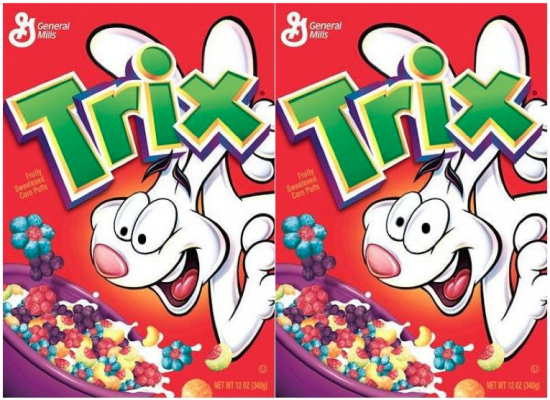“Hey, fluorescent anthropomorphized characterization of a wild or mythical creature—what the hell are you staring at?”
“Kiddie-consumer prey.”
With the exception of fast food, more money is spent marketing cereal to children than any other type of food. And when it comes to pushing sugar-laden varieties on children, marketing efforts revolve around wacky, brand-evangelizing characters. Frosted Flakes employs a leering tiger. Trix’s contortionist rabbit looks to be wired on sugar—or maybe meth, which could explain its chronic kleptomania. And a colorful toucan hawks Froot Loops.
“Eye contact, then, appears to increase feelings of trust and connection to a brand, as well as choice of the brand over competing brands.”
It’s creepy enough that corporate cartoons are being used to push toxic sugar on naive children. But it gets creepier. New research suggests that these characters are gazing from grocery-store shelves deep into children’s eyes. The researchers found that this could persuade the kids to demand that their parents purchase the cereal for them.
Yale and Cornell university researchers visited 10 grocery stores in New York and Connecticut, where they studied the gazes of 57 cereal characters targeted at children. They found that they looked downward from the lower shelves by about 10 degrees, on average. From four feet away, they were staring, on average, at a height of about 20 inches, which means they were often gazing directly into the eyes of passing children. The 29 characters studied on brands targeted at adults looked upwards very slightly or straight ahead from the upper shelves.
The researchers also showed 63 university students cereal boxes in which the character’s gazes had sometimes been digitally manipulated. When the character looked into the eyes of the students, they reported feeling a greater connection to the cereal. Feelings of trust were also slightly higher than when the character was looking elsewhere.
The students were offered a choice of Trix or Fruity Pebbles. By redirecting the wired Trix rabbit’s gaze into the eyes of the students, the percentage who opted for that brand rose from 48 percent to 61 percent.

The original is on the left. The box on the right was more popular with university students.
“Eye contact, then, appears to increase feelings of trust and connection to a brand, as well as choice of the brand over competing brands,” the researchers wrote in their paper, which was published online this week by Environment and Behavior.
Despite the vast sums spent on marketing by cereal companies, Aner Tal, a post-doctoral researcher in Cornell University’s Food and Brand Lab and a study co-author, couldn’t say for sure whether the brand’s illustrators are aiming to make cartoonish eye contact with children. It might just be an unfortunate accident.
“In many of the cases, the fact that the gaze is aimed at a height that would reach children is actually a side-effect of the fact that the characters are looking down towards the bowls of cereal,” Tal said.
Next, perhaps cereal companies could create cartoon endocrinologists—to teach customers how to manage their Type 2 diabetes.


